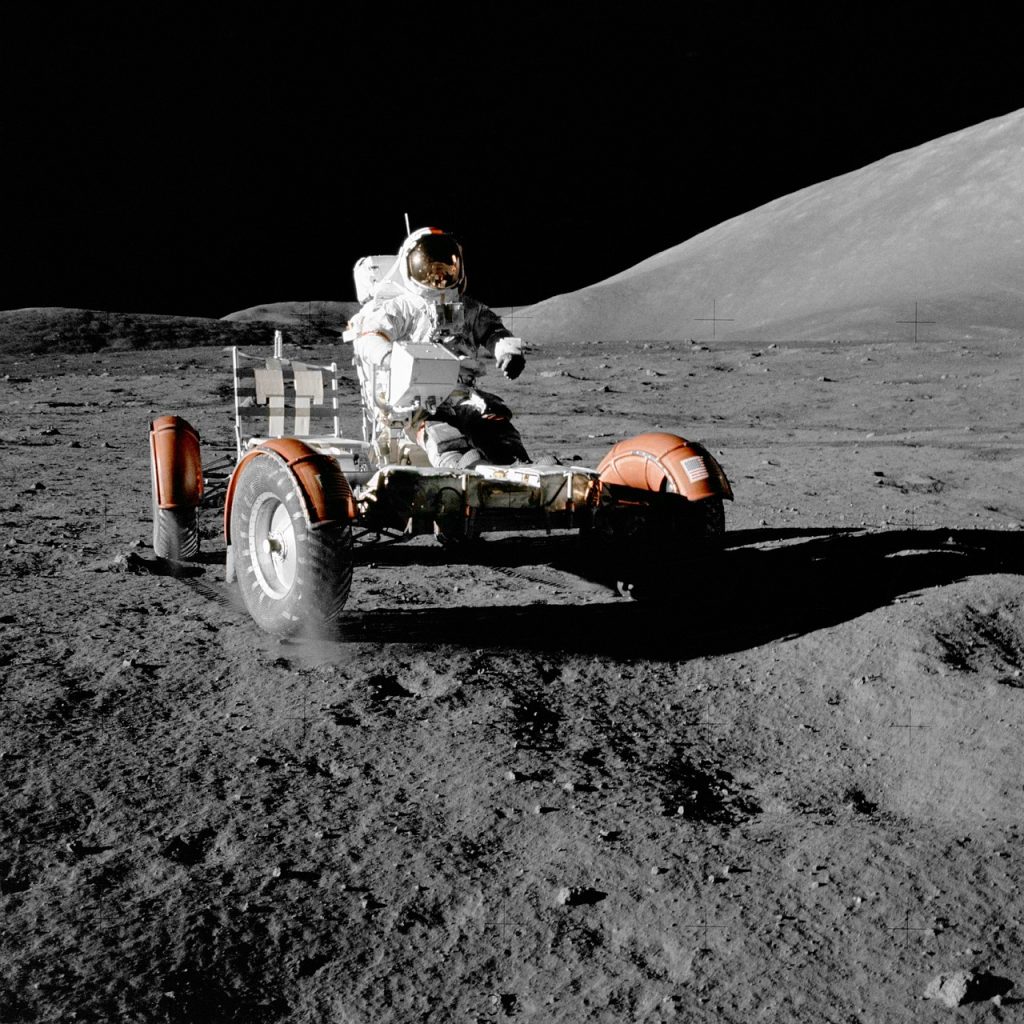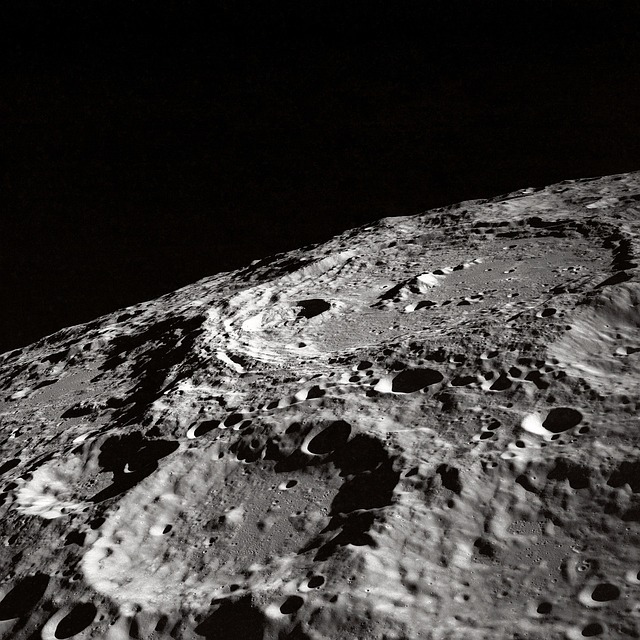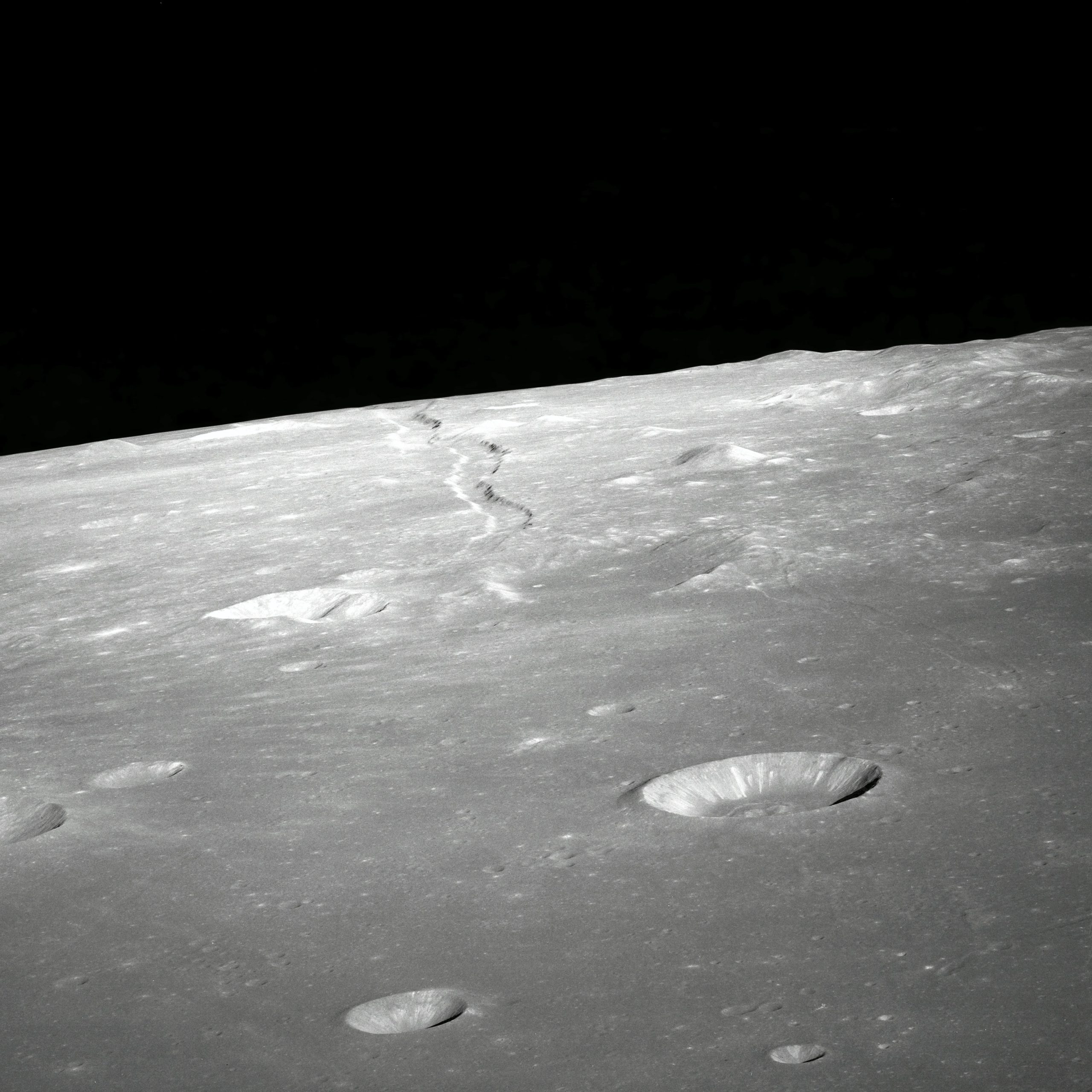The surface of the moon is a barren, rocky landscape that is covered in a layer of fine dust called regolith. The surface is marked by vast plains, deep craters, towering mountains, and jagged ridges, which were formed over billions of years of meteorite impacts, volcanic activity, and seismic activity.

One of the most distinctive features of the lunar surface is its craters. The moon is pockmarked with thousands of craters, ranging in size from tiny pits to massive impact basins. These craters were created when asteroids, comets, and other space debris collided with the moon’s surface, ejecting large amounts of debris and forming a circular depression in the crust.
The largest of these craters is the South Pole-Aitken Basin, which is located on the far side of the moon and measures over 2,500 kilometers in diameter. This basin is thought to be one of the oldest and deepest impact basins in the solar system, and it is believed to have been formed by a collision with a massive asteroid or comet.
In addition to craters, the lunar surface is also marked by vast plains known as “maria.” These plains were formed by ancient volcanic eruptions that flooded the surface with lava, creating dark, flat areas that stand out against the brighter, cratered terrain. The most famous of these maria is the Sea of Tranquility, which is where the Apollo 11 mission landed in 1969, marking the first time humans set foot on the moon.
The lunar surface also features towering mountains and jagged ridges. These features were formed by tectonic activity and the slow cooling and contraction of the moon’s interior. The Taurus-Littrow Valley, located near the Apollo 17 landing site, is home to the highest mountains on the moon, which rise up to 4,500 meters above the valley floor.
The surface of the moon is covered in a layer of fine dust called regolith, which is composed of tiny particles of rock and other materials. This dust was formed by billions of years of meteorite impacts and erosion, and it covers the entire surface of the moon to a depth of several meters.

The regolith is extremely fine and powdery, and it poses a significant challenge to human exploration of the moon. During the Apollo missions, the regolith caused problems with equipment and spacesuits, and it also made it difficult for the astronauts to move around on the surface.
Despite these challenges, the lunar surface remains an area of significant scientific interest and exploration. In recent years, several countries and private companies have announced plans to send missions to the moon to conduct scientific research and exploration, and to prepare for future human missions to the lunar surface.
In conclusion, the surface of the moon is a barren, rocky landscape that is marked by vast plains, deep craters, towering mountains, and jagged ridges. The surface is covered in a layer of fine dust called regolith, which was formed by billions of years of meteorite impacts and erosion. Despite its challenges, the lunar surface remains an area of significant scientific interest and exploration, and we continue to learn more about the moon’s history and composition through ongoing research and exploration efforts.
What are the challenges of establishing a human presence on the moon?
Establishing a human presence on the moon is a complex and challenging endeavor, and there are several significant challenges that need to be overcome. Here are some of the key challenges:
Radiation exposure: The moon has no atmosphere to protect humans from cosmic radiation and solar flares, which can be harmful to human health. Long-term exposure to radiation can increase the risk of cancer, cataracts, and other health problems.
Extreme temperature variations: The lunar surface experiences extreme temperature variations, ranging from as low as -173°C (-279°F) at night to as high as 127°C (261°F) during the day. This makes it challenging to design habitats and spacesuits that can withstand these conditions.
Dust: The lunar surface is covered in a layer of fine dust called regolith, which can be abrasive and harmful to human health if it is inhaled. The dust also poses a challenge to equipment and machinery, as it can clog filters and damage moving parts.
Communication: The moon is far from Earth, and communication delays can make it challenging to control equipment and communicate with astronauts in real-time. Maintaining communication and transportation links with the moon is critical for human exploration, but it can be challenging due to the distance between the moon and Earth, as well as the potential for signal interference. To address this challenge, researchers are exploring new communication technologies, such as laser-based communication, as well as developing new transportation systems, such as reusable lunar landers and ascent vehicles.
Logistics: Establishing a human presence on the moon requires transporting people, equipment, and supplies over long distances and setting up infrastructure to support human life. This is a complex and expensive process that requires significant planning and coordination.
Psychological and social challenges: Living and working in a confined and isolated environment for an extended period can take a toll on astronauts’ mental health and well-being. This requires careful consideration of factors such as crew selection, communication protocols, and support systems.
Food and water: In order to sustain a human presence on the moon, astronauts will need a reliable source of food and water. This could involve growing crops using hydroponic systems or other technologies, or using water extracted from lunar ice deposits.
Energy: Establishing a sustainable human presence on the moon will require a reliable source of energy to power habitats, equipment, and other infrastructure. To address this challenge, researchers are exploring new energy technologies, such as solar power, nuclear power, and fuel cells, as well as studying ways to minimize energy usage through energy-efficient design.
Air and waste management: Managing air quality and waste will be critical to maintaining a healthy and livable environment on the moon. This could involve using regenerative life support systems that recycle air and water, or developing new technologies for waste management and disposal.
These are just a few of the challenges that need to be overcome to establish a human presence on the moon. Despite these challenges, ongoing research and development are making progress in addressing these issues, and many experts believe that a sustainable human presence on the moon is achievable in the years to come.


I’m often to blogging and i really appreciate your content. The article has actually peaks my interest. I’m going to bookmark your web site and maintain checking for brand spanking new information.
toptan hırdavat ürünleri,toptan hırdavat malzemesi,hırdavat malzemesi toptan,toptan hırdavat malzemeleri İstanbul,nalbur fiyat listesi,toptan hırdavat fiyatları,uygun hırdavat,toptan hirdavat malzemeleri,toptan hırdavat,nalburda satılan malzemeler,toptan hırdavat İstanbul,
kombi servisi için en uygun fiyat garantisi arayın hemen kapınıza kadar aynı gün gelelim.
I am truly thankful to the owner of this web site who has shared this fantastic piece of writing at at this place.
This is my first time pay a quick visit at here and i am really happy to read everthing at one place
I very delighted to find this internet site on bing, just what I was searching for as well saved to fav
Very well presented. Every quote was awesome and thanks for sharing the content. Keep sharing and keep motivating others.